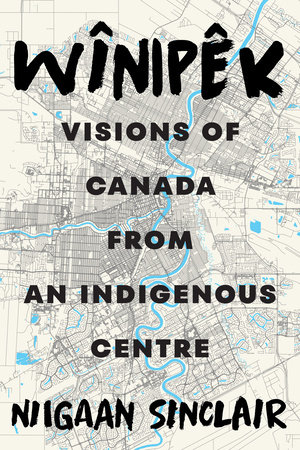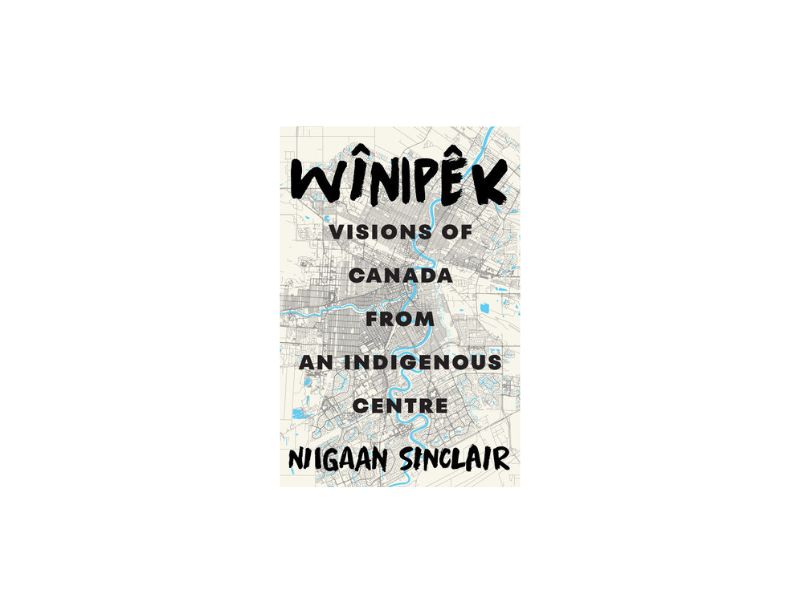Wînipêk: Visions of Canada from an Indigenous Centre is a collection of essays by Niigaan Sinclair that illuminate the reality of Indigenous life in Canada. The essays, published by Penguin Random House Canada, focus on current day people, experiences, and events. They highlight the racism and inequalities affecting Indigenous peoples and the devastating effects, still felt today, of colonialism and the Indian Act. They also showcase positive changes and reasons for hope. Many of the pieces draw from Sinclair’s own personal experiences and his family. They are told with a mix of indignation, outrage, reverence, humour, love, hope, and a call to action.

Niigaan Sinclair is Anishinaabe (St. Peter’s/Little Pequis), a professor at the University of Manitoba Department of Indigenous Studies, a writer, and a commentator on Indigenous issues. He is a regular columnist with the Free Press in Winnipeg, Manitoba, Canada. Most of the writings in the book come from the columns he wrote for that paper.
Sinclair explains the name of the book. Wînipêg is a Cree and Anishinaabe word derived from wiinad, meaning “dirty,” and nibiing, meaning “waters.” The name refers to the ecological system of what is now known as Lake Winnipeg. With the arrival of European settlers and the creation of treaties, the name morphed into Winnipeg. When the city was created in and around Upper Fort Garry, it was named Winnipeg.
Sinclair says that Winnipeg has been at the centre of Indigenous and non-Indigenous relationships on Turtle Island (North America) for centuries. Today, Winnipeg has the highest percentage of Indigenous Peoples in the country outside of the northern territories (about 18.5 percent, nearly four times the national average). Sinclair says “the city is a microcosm of the way Indigenous People have experienced the country as a whole.” The racism that exists throughout the country is more visible here, but the city is also defining creative solutions. He calls Winnipeg “ground zero” of Reconciliation in Canada. Many of the essays are firmly rooted in Winnipeg, but also speak to the Indigenous experience across Canada.
The book starts with a piece about the toppling of two statues on the grounds of the Manitoba Legislative Building on Canada Day 2021. A statue of Queen Victoria, the largest and most prominent statue on the grounds for years, was turned over and marked to commemorate lost residential school children and murdered and missing Indigenous women, girls, and two-spirited people. A statue of Queen Elizabeth II was turned face down and covered in ropes. Sinclair wryly suggests they became the first monuments on the grounds to recognize First Nations Peoples, ironically created out of statues celebrating Canada’s colonial past. This introduction resonated with me. A few days prior to that Canada Day, I had visited the Manitoba Legislative Building grounds, specifically to look at the many statues on it. I had been struck by the lack of First Nations representation. There were statues honouring colonial settlers, immigrants from many countries, feminist activists, and veterans. There was a statue of Métis leader Louis Riel, but nothing for First Nations. It was as if they were being erased from history much in the same way colonial policies over the years had attempted to erase their culture and very being.
It seems a fitting introduction to the book. Sinclair’s essays include bits of information about the complex history, but this is not a history book. It is very much about today. The present has been shaped by history and the historical information provides context. The book’s essays focus on the current day situation and touch on where we go from here.
(Note: In fall of 2024, a statue of Chief Peguis will be erected on the Manitoba Legislative Building grounds in the spot where the Queen Victoria statue previously sat. The Saulteaux chief was one of five Saulteaux and Cree chiefs who signed a treaty with Lord Selkirk in 1807 to provide an area for settlement purposes. Peguis and his people aided the Selkirk settlers.)
Because the essays cover such a wide range of topics, I find it difficult to do a simple overview of them. Some of the topics include alga on Lake Winnipeg, early treaties, Indigenous writing and symbols, farming methods, and Indigenous science and spiritualty. Sinclair speaks of the injustices and inequities Indigenous peoples still face: implicit bias, unequal health care, forcible relocations, missing and murdered Indigenous women and girls, the lasting effects of the residential school system. He doesn’t just speak in general terms buts gets specific with the experiences and voices of various individuals as well as his own experiences. We meet many interesting people in these essays. Their stories and words make it personal and real in a way general information and statistics can’t.
Sinclair talks of the flooding in many Indigenous communities, flooding that has been made worse by the creation of hydro-electric dams, and the lack of dikes and flood protection that is found in non-Indigenous communities. There’s an essay about the creation of Niizhoziibean at The Forks site in central Winnipeg as a “place to meet and experience the traditions of all Aboriginal groups” and one about the centuries of history unearthed in archeologist digs at The Forks. He talks about his relationship with his grandfather, who was a residential school survivor and a World War II veteran, and his work with the Mama Bear Clan, a women-led volunteer group patrolling some of Winnipeg’s toughest streets. He talks about community, the importance of traditions, Indigenous tourism, the teaching of Indigenous languages, the Winnipeg Jets and reconciliation, and how Indigenous youth are making a new reality. And more.
All of the essays combine to portray a multi-faceted picture of the present-day Indigenous experience . The essays are well-written and compelling. They will make you think and feel. I was interested and engaged as I read through them. I feel I have gained insight and perhaps a broader lens for viewing the events, places, and people of my home city.
As someone who has lived in Manitoba all my life and specifically in Winnipeg for decades, many of the events and places mentioned were familiar to me. As I read the book, I wondered how it might connect with someone from somewhere else. Near the beginning of the book, Sinclair says, “The life that exists in whatever we call this place—Wînipêk, Winnipeg, Treaty 1, Manitoba—is rich, dynamic, and the centre of many things; most namely, life. It is this spirit I hopefully have documented here in a city I know, love, and live every day—full of complicated, complete, and beautiful relations from all walks of life. From a place defining this centre, I hope to give others a small sense of what is taking place here.” I think he has done that.
You’ll find black-and-white photos on some of the pages in the book. Many are courtesy of the Winnipeg Free Press. Others have been taken by photographer Dan Harper for the book.
In his closing words, Sinclair talks about the election in Manitoba in 2023 of Canada’s first First Nations Premier and the wearing of orange shirts and unveiling of monuments for Truth and Reconciliation Day. He says, “Something special is happening in this place.” He also goes on to say there is still so much work to do. He believes four steps are necessary: Listen, Learn. Commit. Act.
“Listen to Indigenous Peoples when they bravely articulate their experiences and their family’s experiences of the last 150 years . . . Listen to the silence when Indigenous Peoples are shut out of rooms when decisions are made about their lives . . . Learn how Indigenous Peoples are not the ‘problems’ or the ‘stains’ or the ‘burden’ of this country . . . Lean how privilege creates imbalances and opportunities one is not even aware of. . . . Commit to moral, social, cultural, legal, and economic change.” Then comes the bravest step of all: Act. “Fulfill this vision. Don’t just be an ally, but live as one.”
Wînipêk: Visions of Canada from an Indigenous Centre can certainly help you Listen and Learn.
Thanks to Penquin Random House Canada for providing me with a copy of this book. The review contains my honest impressions of the book and was not seen by the publishing house before posting.

Be First to Comment